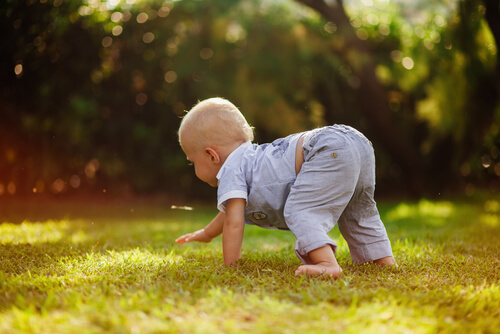Stages of Crawling in Babies

In this article we’ll talk about some of the different benefits and stages of crawling in babies.
A baby’s development occurs sequentially, which means that one skill learned will help another to emerge. First, the baby begins with simple functions, and as he learns, he begins to have more complex skills.
For example, before starting to walk, the baby will go through the stages of crawling. This will help him move from one place to another and prepare him to start using his legs.
The parts of the nervous system act in a coordinated way. Each area interacts with others so that all of the baby’s skills evolve correctly.
This development is linear, from top to bottom, as indicated by the law of cephalo-caudal development; that is, from head to toe.
On the other hand, the law of proximal-distal development starts from the center of the body and goes outward.
How the stages of crawling begin
Babies will start the stages of crawling around the end of their first year, around 9 months old.
However, we must first emphasize that each child develops at their own pace and not all children go through the crawling stage. In other words, some babies learn to walk without the need to crawl.
The development of movement is divided into gross motor skills and fine motor skills.
Gross motor skills involve postural control, locomotion and body coordination, whereas fine motor skills are related to hand-eye coordination, graphomotor skills, etc.

Once the child is able to keep his head straight and prop up on his arms, he can learn to turn around. This will help him begin to develop certain new skills.
The crawling and walking stages require rotation movements, which are independent between the shoulders and the hip and which are also synchronized.
Skills that come from the crawling stage are:
- Rhythm
- Coordination
- Corporal dimension
- Development of the limbs
Tips to promote crawling
Thanks to the crawling stage, the baby can develop touch, vision, speech, orientation, perception, balance and different types of movements.
Here are some tips to help your child learn how to crawl. If you notice that he starts to put himself in these positions, you can start to put these tips into practice:
- When the baby begins to move with his hands, you can stand behind him and direct his legs to perform the synchronous movement and to start crawling. The most important thing is that the child wants to move and uses any part of his body to start doing it.
- When the baby is sitting, it is important to help him support his hands forward. At that time, he should bend his knees and direct his feet backward with a slight push. This way he’ll be in a crawling position.
- Once the child is in the crawling position, he’ll gradually learn to move from the sitting position to the crawling position, and will discover that he can swing back and forth when he’s in that position.
- After this process, he should begin to see that if he presses the ground with his knees, he gets a small boost, just what he needs to start crawling. Finally, he’ll begin to move from a sitting to a crawling position. It’s ideal for him to perfect his technique and successfully crawl by 12 months.
Developmental advantages of crawling
A child’s motor activity is related to the development of his intelligence. For example, in the case of writing, a child must correctly develop fine motor skills and have correct tonic-postural regulation.
Thus, crawling also provides some important benefits at the learning level, which include:
- The crossed pattern of movement involves the neurological function that makes corporal displacement possible. It consists of moving the right arm with the foot on the opposite side, and doing the same with the other arm and other foot. When babies crawl, they tone their muscles, which allows them to tone their spines and later to stand upright.
- Crawling helps babies exercise and perfect their vision. They learn to focus both eyes at a distance of 30-40 centimeters.
- The vestibular system is developed, which is responsible for regulating balance.

- Crawling stimulates the tactile sensors in the palm of the hand.
- In the stages of crawling, hand-eye coordination is matured.
- It connects the cerebral hemispheres, creating information routes for the maturation of cognitive functions.
- It helps establish the lateralization of the brain at around 5-6 years of age.
- Children develop their communication skills by exploring and interacting with their world.
Learning to crawl is very important for babies and generates many benefits. Try to stimulate crawling with these tips so your child can learn in the fastest way possible.
In this article we’ll talk about some of the different benefits and stages of crawling in babies.
A baby’s development occurs sequentially, which means that one skill learned will help another to emerge. First, the baby begins with simple functions, and as he learns, he begins to have more complex skills.
For example, before starting to walk, the baby will go through the stages of crawling. This will help him move from one place to another and prepare him to start using his legs.
The parts of the nervous system act in a coordinated way. Each area interacts with others so that all of the baby’s skills evolve correctly.
This development is linear, from top to bottom, as indicated by the law of cephalo-caudal development; that is, from head to toe.
On the other hand, the law of proximal-distal development starts from the center of the body and goes outward.
How the stages of crawling begin
Babies will start the stages of crawling around the end of their first year, around 9 months old.
However, we must first emphasize that each child develops at their own pace and not all children go through the crawling stage. In other words, some babies learn to walk without the need to crawl.
The development of movement is divided into gross motor skills and fine motor skills.
Gross motor skills involve postural control, locomotion and body coordination, whereas fine motor skills are related to hand-eye coordination, graphomotor skills, etc.

Once the child is able to keep his head straight and prop up on his arms, he can learn to turn around. This will help him begin to develop certain new skills.
The crawling and walking stages require rotation movements, which are independent between the shoulders and the hip and which are also synchronized.
Skills that come from the crawling stage are:
- Rhythm
- Coordination
- Corporal dimension
- Development of the limbs
Tips to promote crawling
Thanks to the crawling stage, the baby can develop touch, vision, speech, orientation, perception, balance and different types of movements.
Here are some tips to help your child learn how to crawl. If you notice that he starts to put himself in these positions, you can start to put these tips into practice:
- When the baby begins to move with his hands, you can stand behind him and direct his legs to perform the synchronous movement and to start crawling. The most important thing is that the child wants to move and uses any part of his body to start doing it.
- When the baby is sitting, it is important to help him support his hands forward. At that time, he should bend his knees and direct his feet backward with a slight push. This way he’ll be in a crawling position.
- Once the child is in the crawling position, he’ll gradually learn to move from the sitting position to the crawling position, and will discover that he can swing back and forth when he’s in that position.
- After this process, he should begin to see that if he presses the ground with his knees, he gets a small boost, just what he needs to start crawling. Finally, he’ll begin to move from a sitting to a crawling position. It’s ideal for him to perfect his technique and successfully crawl by 12 months.
Developmental advantages of crawling
A child’s motor activity is related to the development of his intelligence. For example, in the case of writing, a child must correctly develop fine motor skills and have correct tonic-postural regulation.
Thus, crawling also provides some important benefits at the learning level, which include:
- The crossed pattern of movement involves the neurological function that makes corporal displacement possible. It consists of moving the right arm with the foot on the opposite side, and doing the same with the other arm and other foot. When babies crawl, they tone their muscles, which allows them to tone their spines and later to stand upright.
- Crawling helps babies exercise and perfect their vision. They learn to focus both eyes at a distance of 30-40 centimeters.
- The vestibular system is developed, which is responsible for regulating balance.

- Crawling stimulates the tactile sensors in the palm of the hand.
- In the stages of crawling, hand-eye coordination is matured.
- It connects the cerebral hemispheres, creating information routes for the maturation of cognitive functions.
- It helps establish the lateralization of the brain at around 5-6 years of age.
- Children develop their communication skills by exploring and interacting with their world.
Learning to crawl is very important for babies and generates many benefits. Try to stimulate crawling with these tips so your child can learn in the fastest way possible.
All cited sources were thoroughly reviewed by our team to ensure their quality, reliability, currency, and validity. The bibliography of this article was considered reliable and of academic or scientific accuracy.
- de Avila Aburdene, R., & Castro Kukoc, M. (2005). Relaciones con el inicio de la marcha, gateo, uso de andadores y accidentes. Revista de la sociedad boliviana de pediatría, 44(1), 11-14.
- Ojeda Alberca, E. (2018). El gateo en el desarrollo cognitivo en niños menores de 2 años.
- Oldak-Kovalsky, B., & Oldak-Skvirsky, D. (2016). Gateo. Revisión de la literatura médica. Revista Mexicana de Pediatría, 82(4), 144-148.
This text is provided for informational purposes only and does not replace consultation with a professional. If in doubt, consult your specialist.








